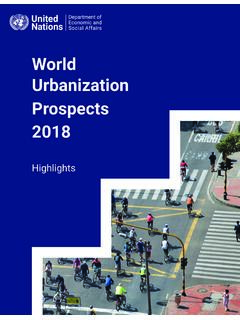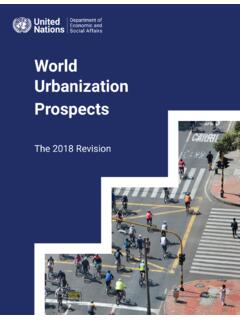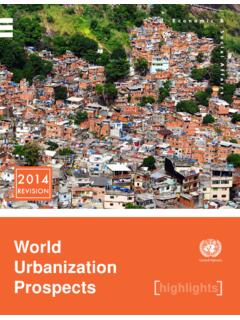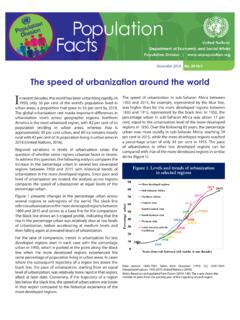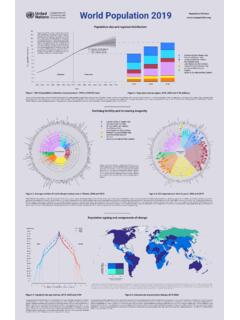Transcription of World Urbanization Prospects: The 2018 Revision - Un
1 E c o n o m i c &S o c i a l A f f a i r s[ key facts ] World Urbanization prospects : The 2018 RevisionWorld Urbanization prospects : The 2018 Revision Globally, more people live in urban areas than in rural areas, with 55 % of the World s population residing in urban areas in 2018. In 1950, 30 % of the World s population was urban, and by 2050, 68 % of the World s population is projected to be urban. Today, the most urbanized regions include Northern America (with 82 % of its population living in urban areas in 2018), Latin America and the Caribbean (81 %), Europe (74 %) and Oceania (68%). The level of Urbanization in Asia is now approximating 50 %. In contrast, Africa remains mostly rural, with 43 % of its population living in urban areas. The rural population of the World has grown slowly since 1950 and is expected to reach its peak in a few years. The global rural population is now close to billion and is expected to rise slightly and then decline to around billion in 2050.
2 Africa and Asia are home to nearly 90 % of the World s rural population. India has the largest rural population (893 million), followed by China (578 million). The urban population of the World has grown rapidly since 1950, having increased from 751 million to billion in 2018. Asia, despite being less urbanized than most other regions today, is home to 54 % of the World s urban population, followed by Europe and Africa (13 % each). Growth in the urban population is driven by overall population increase and by the upward shift in the percentage living in urban areas. Together, these two factors are projected to add billion to the World s urban population by 2050, with almost 90 % of this growth happening in Asia and Africa. Just three countries India, China and Nigeria together are expected to account for 35 % of the growth in the World s urban population between 2018 and 2050. India is projected to add 416 million urban dwellers, China 255 million and Nigeria 189 million.
3 Close to half of the World s urban dwellers reside in settlements with fewer than 500,000 inhabitants, while around one in eight live in 33 megacities with more than 10 million inhabitants. By 2030, the World is projected to have 43 megacities, most of them in developing regions. Tokyo is the World s largest city with an agglomeration of 37 million inhabitants, followed by Delhi with 29 million, Shanghai with 26 million, and Mexico City and S o Paulo, each with around 22 million inhabitants. Today, Cairo, Mumbai, Beijing and Dhaka all have close to 20 million inhabitants. Some cities have experienced population decline in recent years. Most of these are located in the low-fertility countries of Asia and Europe where overall population sizes are stagnant or declining. Economic contraction and natural disasters have contributed to population losses in some cities as Urbanization is key to successful development As the World continues to urbanize, sustainable development depends increasingly on the successful management of urban growth, especially in low-income and lower-middle-income countries where the most rapid Urbanization is expected between now and 2050.
4 Integrated policies to improve the lives of both urban and rural dwellers are needed, strengthening the linkages between urban and rural areas and building on their existing economic, social and environmental ties. Urban growth is closely related to the three dimensions of sustainable development: economic, social and environmental. Well-managed Urbanization , informed by an understanding of population trends over the long run, can help to maximize the benefits of agglomeration while minimizing environmental degradation and other potential adverse impacts of a growing number of city dwellers. To ensure that the benefits of Urbanization are shared and that no one is left behind, policies to manage urban growth need to ensure access to infrastructure and social services for all, focusing on the needs of the urban poor and other vulnerable groups for housing, education, health care, decent work and a safe environment.

